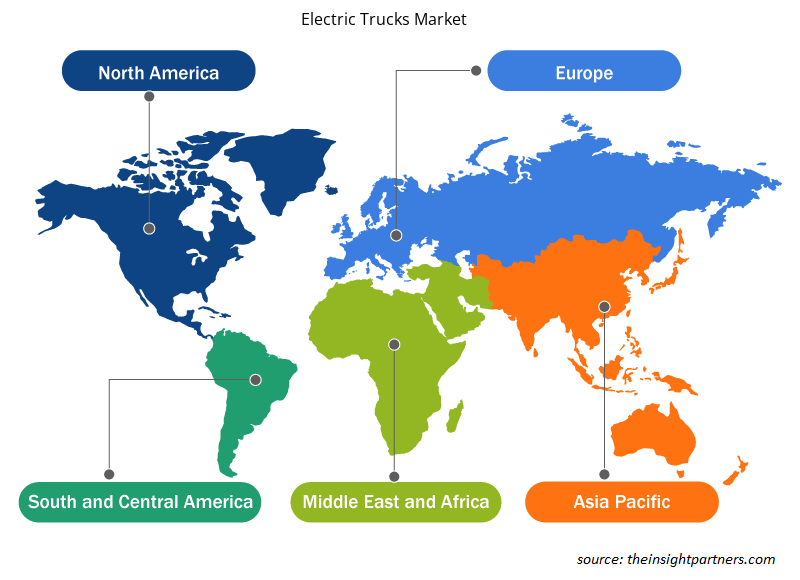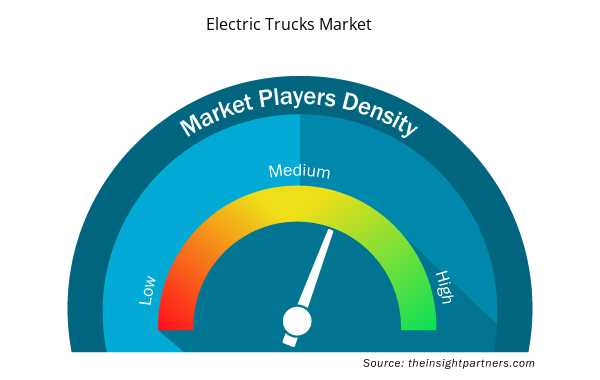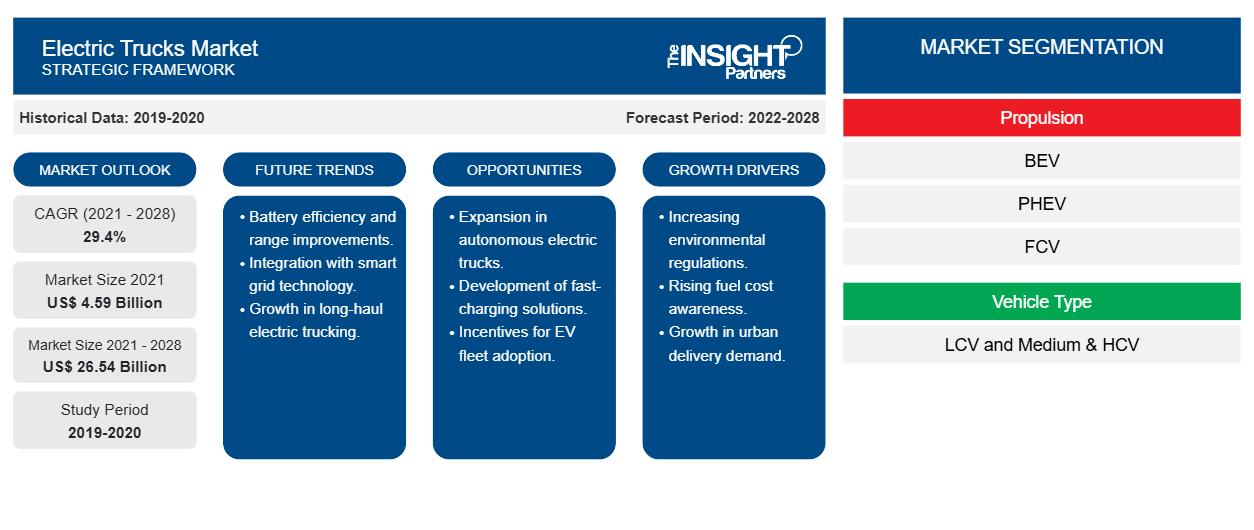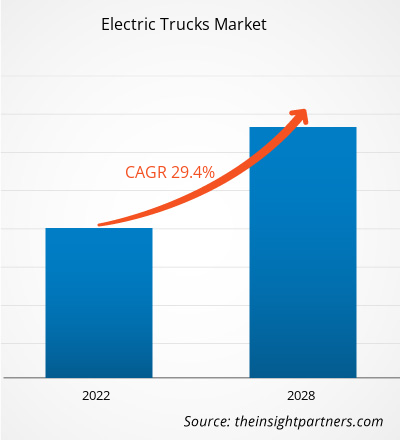电动卡车市场预计将从 2021 年的 45.9255 亿美元增长到 2028 年的 265.429 亿美元;预计 2022 年至 2028 年的复合年增长率为 29.4%。CAGR of 29.4% from 2022 to 2028.
全球汽车行业正在经历模式转变,逐渐转向替代/低能耗解决方案。石油价格上涨、污染水平上升以及应对全球气候变化的国际承诺正在加速向电动汽车的转变。
电动卡车市场近期主要发展:
- 2021 年 8 月,沃尔沃卡车收购了江铃汽车股份有限公司旗下江铃重型汽车有限公司在中国的一家重型卡车制造厂。此次收购还包括位于中国山西省太原市的一家生产工厂。目标是在 2022 年底前在太原开始为中国客户生产新型重型沃尔沃 FH、沃尔沃 FM 和沃尔沃 FMX 卡车。
- 2021 年 9 月,比亚迪在加州 ACT Expo 上发布了两款革命性的纯电动重型卡车。这些卡车标配高级驾驶辅助系统 (ADAS),让驾驶更轻松、更安全。
根据推进方式,电动卡车市场细分为 BEV、PHEV 和 FCEV。2021 年,BEV 细分市场以最大的份额引领市场。根据车型,电动卡车市场分为 LCV、中型和 HCV。2021 年,LCV 细分市场以更大的份额引领市场。根据续航里程,电动卡车市场分为少于 200 英里和超过 200 英里。2021 年,200 英里以上的细分市场占据了更大的市场份额。根据自动化水平,电动卡车市场细分为半自动和全自动。2021 年,半自动细分市场以更大的份额引领市场。按地域划分,电动卡车市场主要分为北美、欧洲、亚太地区 (APAC)、中东和非洲 (MEA) 和南美 (SAM)。 2021 年,欧洲占据了相当大的市场份额
定制此报告以满足您的需求
您可以免费定制任何报告,包括本报告的部分内容、国家级分析、Excel 数据包,以及为初创企业和大学提供优惠和折扣
- 获取此报告的关键市场趋势。这个免费样品将包括数据分析,从市场趋势到估计和预测。
COVID-19 疫情对电动卡车市场的影响
2020 年,COVID-19 疫情导致汽车产量下降,阻碍了电动卡车市场的增长。COVID-19 对不同地区的电动汽车市场产生了不同程度的影响。许多电动汽车原始设备制造商正试图建立在线商业模式和非接触式销售渠道,以应对社交距离趋势和消费者在购物时不愿避开人群的现状。尽管如此,由于 COVID 之后的需求激增,2020 年新的电动汽车工厂建设计划已经制定。然而,在 2020 年前三个季度,由于 COVID-19,没有一家新建的电动汽车工厂投入运营。
市场洞察 – 电动卡车市场
对可持续出行方式的接受度不断提高
可持续出行方式的日益普及,推动了电动卡车(包括续航里程更长的电池电动卡车和燃料电池电动卡车)和其他电动汽车的引入,以应对要求苛刻的长途运输。预计 2022-2028 年期间将推出使用氢燃料电池的电动卡车。为了减轻气候对交通的影响,需要从化石燃料迅速过渡到电力等替代能源。因此,大多数运输企业可能会分阶段过渡到电动汽车。在过渡期间,许多企业将拥有使用不同燃料的混合卡车车队。
电动汽车将通过更高效、更清洁的交通方式节约能源,从而使各国政府能够实现联合国制定的可持续发展目标 (SDG)。与其他电动汽车一样,电动卡车将有助于减少尾气污染、减少对化石燃料的依赖、促进社区健康、提供能源安全以及改善就业和技能提升机会。将电动汽车目标与可再生能源目标结合起来将有助于进一步降低交通运输行业的碳排放。欧洲以及发展中地区的企业和政府机构可以通过提供电动汽车充电基础设施和将车队车辆换成电动卡车,在减少全球温室气体排放和促进电动卡车普及方面发挥重要作用。
基于推进的洞察
根据推进方式,电动卡车市场分为 BEV、FCV 和 PHEV。BEV 细分市场在 2021 年占据了最大的市场份额。电池供电的电动卡车预计将为市场增长做出显著贡献。沃尔沃和 Navistar 等制造商正在利用其技术能力,缩短 BEV 的开发周期,并专注于快速上市。电池寿命和能量密度的增加以及电池价格的下降可能会推动 BEV 细分市场的电动卡车市场。
基于车辆的洞察
根据车型,电动卡车市场分为轻型商用车和中型及重型商用车。2021 年,轻型商用车领域以更大的市场份额领先市场。汽车制造商和联合动力总成零部件供应商正在拥抱电动、清洁和可持续的未来。通过从初始阶段创建新范式,多家 OEM 正在改变建立轻型商用车平台的传统方式。许多重要的 OEM 正在开发特定的 eLCV 平台。与此同时,车队经理对高度定制化的需求不断增加,以及新服务模式的引入,使轻型商用车行业受益。
基于范围的洞察
根据续航里程,电动卡车市场分为 200 英里以下和 200 英里以上两类。2021 年,200 英里以上的细分市场以较大的份额领先市场。由于终端用户的偏好,续航里程较长的商用车在全球市场占据主导地位。
基于自动化的洞察
根据自动化程度,电动卡车市场分为半自动和全自动。半自动电动卡车占据了较大的市场份额。然而,由于所有行业越来越多地采用自动化,以及技术的发展使自动驾驶卡车能够完全发挥作用,预计全自动卡车将在未来几年占据市场主导地位。
电动卡车市场区域洞察
Insight Partners 的分析师已详细解释了预测期内影响电动卡车市场的区域趋势和因素。本节还讨论了北美、欧洲、亚太地区、中东和非洲以及南美和中美洲的电动卡车市场细分和地理位置。

- 获取电动卡车市场的区域特定数据
电动卡车市场报告范围
| 报告属性 | 细节 |
|---|---|
| 2021 年市场规模 | 45.9亿美元 |
| 2028 年市场规模 | 265.4亿美元 |
| 全球复合年增长率(2021 - 2028) | 29.4% |
| 史料 | 2019-2020 |
| 预测期 | 2022-2028 |
| 涵盖的领域 | 通过推进
|
| 覆盖地区和国家 | 北美
|
| 市场领导者和主要公司简介 |
|
市场参与者密度:了解其对商业动态的影响
电动卡车市场正在快速增长,这得益于终端用户需求的不断增长,而这些需求又源于消费者偏好的不断变化、技术进步以及对产品优势的认识不断提高等因素。随着需求的增加,企业正在扩大其产品范围,进行创新以满足消费者的需求,并利用新兴趋势,从而进一步推动市场增长。
市场参与者密度是指在特定市场或行业内运营的企业或公司的分布情况。它表明相对于给定市场空间的规模或总市场价值,有多少竞争对手(市场参与者)存在于该市场空间中。
在电动卡车市场运营的主要公司有:
- 沃尔沃集团
- 比亚迪股份有限公司
- 戴姆勒公司
- 第一汽车集团有限公司
- 纳威司达公司
免责声明:上面列出的公司没有按照任何特定顺序排列。

- 了解电动卡车市场顶级关键参与者概况
根据电动卡车市场报告,市场参与者主要关注新产品的发布。
- 2021 年初,沃尔沃卡车推出了新款沃尔沃 FM 电动卡车车型。该车型配备了新的自动化功能,为驾驶员提供了增强的可视性,并配备了集成的电子控制制动系统。
- 2021 年 8 月,纳威司达宣布推出其全新全电动国际 eMV 系列卡车。eMV 卡车旨在将中型卡车体验与零排放相结合,并提供完全集成的电动动力系统解决方案。
- 历史分析(2 年)、基准年、预测(7 年)及复合年增长率
- PEST 和 SWOT 分析
- 市场规模价值/数量 - 全球、区域、国家
- 行业和竞争格局
- Excel 数据集



Report Coverage
Revenue forecast, Company Analysis, Industry landscape, Growth factors, and Trends

Segment Covered
This text is related
to segments covered.

Regional Scope
North America, Europe, Asia Pacific, Middle East & Africa, South & Central America

Country Scope
This text is related
to country scope.
常见问题
The incremental growth of the electric trucks market during the forecast period is US$ 21950.36 million.
Europe is the fastest growing region in the global electric trucks market.
The major five companies in the electric trucks market include Tesla, Volvo, Daimler, BYD and Navister.
Based on type, the electric trucks market is bifurcated into BEV, PHEV, and FCV. In 2021, the BEV segment led the electric trucks market, accounting for the largest share in the market.
Smart charging and connected infrastructure is presenting significant potential for the future growth of the electric trucks market players.
Government initiatives and stringent emission rules to boost the electric trucks growth and surge in global production and sales of EVs are driving the growth of the electric trucks market.
Trends and growth analysis reports related to Automotive and Transportation : READ MORE..
The List of Companies - Electric Trucks Market
- AB Volvo
- BYD Company Ltd
- Daimler AG
- FAW Group Co.,Ltd.
- Navistar, Inc.
- PACCAR Inc.
- Proterra Inc.
- Rivian
- Scania
- Tesla, Inc.
The Insight Partners performs research in 4 major stages: Data Collection & Secondary Research, Primary Research, Data Analysis and Data Triangulation & Final Review.
- Data Collection and Secondary Research:
As a market research and consulting firm operating from a decade, we have published and advised several client across the globe. First step for any study will start with an assessment of currently available data and insights from existing reports. Further, historical and current market information is collected from Investor Presentations, Annual Reports, SEC Filings, etc., and other information related to company’s performance and market positioning are gathered from Paid Databases (Factiva, Hoovers, and Reuters) and various other publications available in public domain.
Several associations trade associates, technical forums, institutes, societies and organization are accessed to gain technical as well as market related insights through their publications such as research papers, blogs and press releases related to the studies are referred to get cues about the market. Further, white papers, journals, magazines, and other news articles published in last 3 years are scrutinized and analyzed to understand the current market trends.
- Primary Research:
The primarily interview analysis comprise of data obtained from industry participants interview and answers to survey questions gathered by in-house primary team.
For primary research, interviews are conducted with industry experts/CEOs/Marketing Managers/VPs/Subject Matter Experts from both demand and supply side to get a 360-degree view of the market. The primary team conducts several interviews based on the complexity of the markets to understand the various market trends and dynamics which makes research more credible and precise.
A typical research interview fulfils the following functions:
- Provides first-hand information on the market size, market trends, growth trends, competitive landscape, and outlook
- Validates and strengthens in-house secondary research findings
- Develops the analysis team’s expertise and market understanding
Primary research involves email interactions and telephone interviews for each market, category, segment, and sub-segment across geographies. The participants who typically take part in such a process include, but are not limited to:
- Industry participants: VPs, business development managers, market intelligence managers and national sales managers
- Outside experts: Valuation experts, research analysts and key opinion leaders specializing in the electronics and semiconductor industry.
Below is the breakup of our primary respondents by company, designation, and region:

Once we receive the confirmation from primary research sources or primary respondents, we finalize the base year market estimation and forecast the data as per the macroeconomic and microeconomic factors assessed during data collection.
- Data Analysis:
Once data is validated through both secondary as well as primary respondents, we finalize the market estimations by hypothesis formulation and factor analysis at regional and country level.
- Macro-Economic Factor Analysis:
We analyse macroeconomic indicators such the gross domestic product (GDP), increase in the demand for goods and services across industries, technological advancement, regional economic growth, governmental policies, the influence of COVID-19, PEST analysis, and other aspects. This analysis aids in setting benchmarks for various nations/regions and approximating market splits. Additionally, the general trend of the aforementioned components aid in determining the market's development possibilities.
- Country Level Data:
Various factors that are especially aligned to the country are taken into account to determine the market size for a certain area and country, including the presence of vendors, such as headquarters and offices, the country's GDP, demand patterns, and industry growth. To comprehend the market dynamics for the nation, a number of growth variables, inhibitors, application areas, and current market trends are researched. The aforementioned elements aid in determining the country's overall market's growth potential.
- Company Profile:
The “Table of Contents” is formulated by listing and analyzing more than 25 - 30 companies operating in the market ecosystem across geographies. However, we profile only 10 companies as a standard practice in our syndicate reports. These 10 companies comprise leading, emerging, and regional players. Nonetheless, our analysis is not restricted to the 10 listed companies, we also analyze other companies present in the market to develop a holistic view and understand the prevailing trends. The “Company Profiles” section in the report covers key facts, business description, products & services, financial information, SWOT analysis, and key developments. The financial information presented is extracted from the annual reports and official documents of the publicly listed companies. Upon collecting the information for the sections of respective companies, we verify them via various primary sources and then compile the data in respective company profiles. The company level information helps us in deriving the base number as well as in forecasting the market size.
- Developing Base Number:
Aggregation of sales statistics (2020-2022) and macro-economic factor, and other secondary and primary research insights are utilized to arrive at base number and related market shares for 2022. The data gaps are identified in this step and relevant market data is analyzed, collected from paid primary interviews or databases. On finalizing the base year market size, forecasts are developed on the basis of macro-economic, industry and market growth factors and company level analysis.
- Data Triangulation and Final Review:
The market findings and base year market size calculations are validated from supply as well as demand side. Demand side validations are based on macro-economic factor analysis and benchmarks for respective regions and countries. In case of supply side validations, revenues of major companies are estimated (in case not available) based on industry benchmark, approximate number of employees, product portfolio, and primary interviews revenues are gathered. Further revenue from target product/service segment is assessed to avoid overshooting of market statistics. In case of heavy deviations between supply and demand side values, all thes steps are repeated to achieve synchronization.
We follow an iterative model, wherein we share our research findings with Subject Matter Experts (SME’s) and Key Opinion Leaders (KOLs) until consensus view of the market is not formulated – this model negates any drastic deviation in the opinions of experts. Only validated and universally acceptable research findings are quoted in our reports.
We have important check points that we use to validate our research findings – which we call – data triangulation, where we validate the information, we generate from secondary sources with primary interviews and then we re-validate with our internal data bases and Subject matter experts. This comprehensive model enables us to deliver high quality, reliable data in shortest possible time.


 获取此报告的免费样本
获取此报告的免费样本